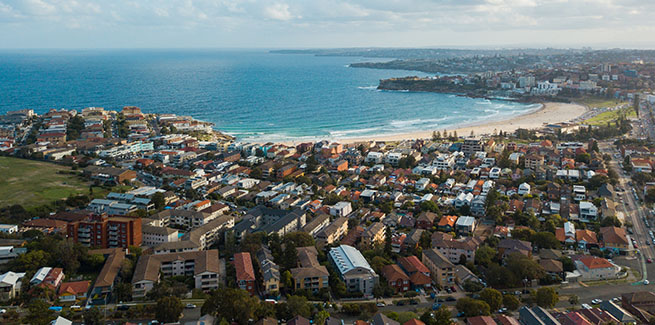A report from Moody’s has forecast housing affordability will continue to worsen into 2022, as property prices rocket and incomes stay stagnant.
The company has noted affordability has eroded across all capital cities for the seven months to September, because of surging prices.
On average, Australian households with two income earners have needed 25.1 per cent of their monthly income to meet monthly mortgage repayments in September, up from 24.6 per cent in February, 23 per cent in September 2020 and just below the 10-year average of 25.8 per cent.
In Sydney, affordability has deteriorated significantly and the worst in a decade is within reach, if prices “rise by a relatively small amount”, the report stated.
Based on Moody’s modelling, housing affordability will hit Sydney’s lowest for 10 years if prices rise by a further 4.6 per cent or if average mortgage lending rates rise by 0.42 percentage points.
Over the seven months to September, new borrowers in Sydney needed 35.4 per cent of their household income to meet mortgage repayments, ranking higher than Melbourne (28.3 per cent), Brisbane (20.6 per cent), Adelaide (20.2 per cent) and Perth (15.3 per cent).
In both Sydney and Melbourne, the share of income borrowers need to meet repayments on new mortgages is now worse than the cities’ averages for the last decade.
If housing prices increase by a further 10 per cent, Moody’s has calculated that borrowers across Australia will need 2.5 percentage points more of their income to meet new mortgage repayments, up to an average of 27.6 per cent.
If prices go up by 15 per cent, the share of income needed to meet mortgage repayments will surpass the 28.9 per cent peak across Australia for the past decade.
However, in Sydney and in Melbourne, much smaller rises are needed. In Melbourne, an 8.7 per cent rise would push the affordability measure above its decade high, whereas in Sydney, it would only need 4.6 per cent (as mentioned before).
For other cities, more significant movements are needed to meet the 10-year records, such as in Brisbane (26.5 per cent), Adelaide (32.2 per cent) and Perth (59.1 per cent).
Affordability for houses had also worsened more than apartments, particularly in Sydney, where house buyers needed 45.2 per cent of their income to meet mortgage repayments in September, compared to 36 per cent in February.
In contrast, the national average was 27.3 per cent of borrowers’ household incomes in September, compared to 26.2 per cent in February.
Meanwhile mortgage lending rates declined by an average of 0.2 percentage points over the seven months to September, but not enough to offset price gains, Moody’s reported.
The paper noted that prices across the country had risen by 13 per cent for all dwelling types and 17.4 per cent for houses over the 12 months to September.
Average prices rose in all capital cities except Perth, with Sydney prices up significantly more than other cities (25.6 per cent for all dwelling types and 40 per cent for houses).
“Over the rest of 2021 and into early 2022, we expect housing affordability will continue to deteriorate moderately, because property prices will continue to increase, while mortgage lending rates and household incomes will stay broadly steady,” the report stated.
However, the pace that property prices have climbed at is expected to slow, with house prices to tail off and demand for apartments to rise, as international borders reopen and immigration resumes next year.
Mortgage lending rates however have likely bottomed, said Moody’s, although they are expected to stay consistently low for some time, before potentially rising after 18 to 24 months if inflation picks up.
Rate rises however would also make affordability worse. If mortgage lending rates picked up by 0.25 percentage points, the share of borrowers who would need to meet repayments on new mortgages would increase by 0.7 percentage points to 25.8 per cent on average in Australia.
If mortgage lending rates rose from the current 3.45 per cent average to the 10-year average of 4.79 per cent, the affordability measure would increase by 3.8 percentage points to 28.9 per cent.
Housing affordability would be worse than at any point in the last 10 years on average in Australia if mortgage lending rates increase to 4.8 per cent.
In Sydney, affordability would be worse than at any time in the past decade if lending rates just rose to 3.87 per cent, while the equivalent would be 4.3 per cent for Melbourne, 5.8 per cent for Perth and 6.2 per cent for Adelaide.
If housing prices rise by a further 10 per cent, then interest rate would only have to increase to 3.87 per cent to push the affordability measure across Australia above its 10-year peak of 28.9 per cent.
As a counterforce, incomes would need to rise substantially to improve affordability, particularly in Sydney.
Moody’s has said if incomes rose by 5 per cent, the share of income needed to meet repayments would decline by 1.2 percentage points to 23.9 per cent. If incomes rose by 10 per cent, the share of income needed would decline by 2.3 percentage points, to 22.8 per cent.
But in Sydney, household incomes would have to rise by 8.1 per cent for the affordability metric to decline from current levels down to the city’s 10-year average of 32.5 per cent.
[Related: Australian home loans at lowest affordability since 2016: Bluestone]

